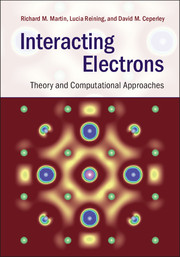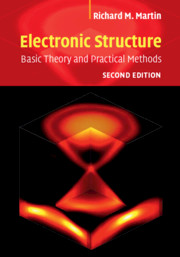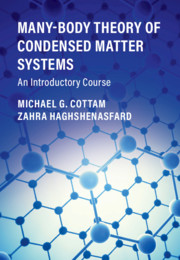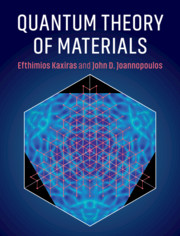Interacting Electrons
Theory and Computational Approaches
$94.99 (C)
- Authors:
- Richard M. Martin, University of Illinois, Urbana-Champaign
- Lucia Reining, École Polytechnique, Paris
- David M. Ceperley, University of Illinois, Urbana-Champaign
- Date Published: July 2016
- availability: Available
- format: Hardback
- isbn: 9780521871501
$
94.99
(C)
Hardback
Other available formats:
eBook
Looking for an examination copy?
If you are interested in the title for your course we can consider offering an examination copy. To register your interest please contact [email protected] providing details of the course you are teaching.
-
Recent progress in the theory and computation of electronic structure is bringing an unprecedented level of capability for research. Many-body methods are becoming essential tools vital for quantitative calculations and understanding materials phenomena in physics, chemistry, materials science and other fields. This book provides a unified exposition of the most-used tools: many-body perturbation theory, dynamical mean field theory and quantum Monte Carlo simulations. Each topic is introduced with a less technical overview for a broad readership, followed by in-depth descriptions and mathematical formulation. Practical guidelines, illustrations and exercises are chosen to enable readers to appreciate the complementary approaches, their relationships, and the advantages and disadvantages of each method. This book is designed for graduate students and researchers who want to use and understand these advanced computational tools, get a broad overview, and acquire a basis for participating in new developments.
Read more- Provides extensive background and theory for each of the methods, which enables readers to understand capabilities as well as limitations, and how to avoid errors when making computations
- Designed to be accessible for beginners with non-technical introductory chapters for each method
- Chapters are complemented with exercises enabling students to master the theory by putting the tools to practical use
Customer reviews
Not yet reviewed
Be the first to review
Review was not posted due to profanity
×Product details
- Date Published: July 2016
- format: Hardback
- isbn: 9780521871501
- length: 840 pages
- dimensions: 253 x 183 x 41 mm
- weight: 1.76kg
- contains: 203 b/w illus. 5 tables 203 exercises
- availability: Available
Table of Contents
Preface
Part I. Interacting Electrons: Beyond the Independent-Particle Picture:
1. The many electron problem: introduction
2. Signatures of electron correlation
3. Concepts and models for interacting electrons
Part II. Foundations of Theory for Many-Body Systems:
4. Mean fields and auxiliary systems
5. Correlation functions
6. Many-body wavefunctions
7. Particles and quasi-particles
8. Functionals in many-particle physics
Part III. Many-Body Green's Function Methods:
9. Many-body perturbation theory: expansion in the interaction
10. Many-body perturbation theory via functional derivatives
11. The RPA and the GW approximation for the self-energy
12. GWA calculations in practice
13. GWA calculations: illustrative results
14. RPA and beyond: the Bethe-Salpeter equation
15. Beyond the GW approximation
16. Dynamical mean field theory
17. Beyond the single-site approximation in DMFT
18. Solvers for embedded systems
19. Characteristic hamiltonians for solids with d and f states
20. Examples of calculations for solids with d and f states
21. Combining Green's functions approaches: an outlook
Part IV. Stochastic Methods:
22. Introduction to stochastic methods
23. Variational Monte Carlo
24. Projector quantum Monte Carlo
25. Path integral Monte Carlo
26. Concluding remarks
Part V. Appendices: A. Second quantization
B. Pictures
C. Green's functions: general properties
D. Matsubara formulation for Green's functions for T ̸= 0
E. Time-ordering, contours, and non-equilibrium
F. Hedin's equations in a basis
G. Unique solutions in Green's function theory
H. Properties of functionals
I. Auxiliary systems and constrained search
J. Derivation of the Luttinger theorem
K. Gutzwiller and Hubbard approaches
References
Index.-
General Resources
Find resources associated with this title
Type Name Unlocked * Format Size Showing of
This title is supported by one or more locked resources. Access to locked resources is granted exclusively by Cambridge University Press to instructors whose faculty status has been verified. To gain access to locked resources, instructors should sign in to or register for a Cambridge user account.
Please use locked resources responsibly and exercise your professional discretion when choosing how you share these materials with your students. Other instructors may wish to use locked resources for assessment purposes and their usefulness is undermined when the source files (for example, solution manuals or test banks) are shared online or via social networks.
Supplementary resources are subject to copyright. Instructors are permitted to view, print or download these resources for use in their teaching, but may not change them or use them for commercial gain.
If you are having problems accessing these resources please contact [email protected].
Sorry, this resource is locked
Please register or sign in to request access. If you are having problems accessing these resources please email [email protected]
Register Sign in» Proceed
You are now leaving the Cambridge University Press website. Your eBook purchase and download will be completed by our partner www.ebooks.com. Please see the permission section of the www.ebooks.com catalogue page for details of the print & copy limits on our eBooks.
Continue ×Are you sure you want to delete your account?
This cannot be undone.
Thank you for your feedback which will help us improve our service.
If you requested a response, we will make sure to get back to you shortly.
×






